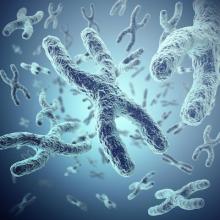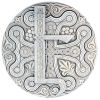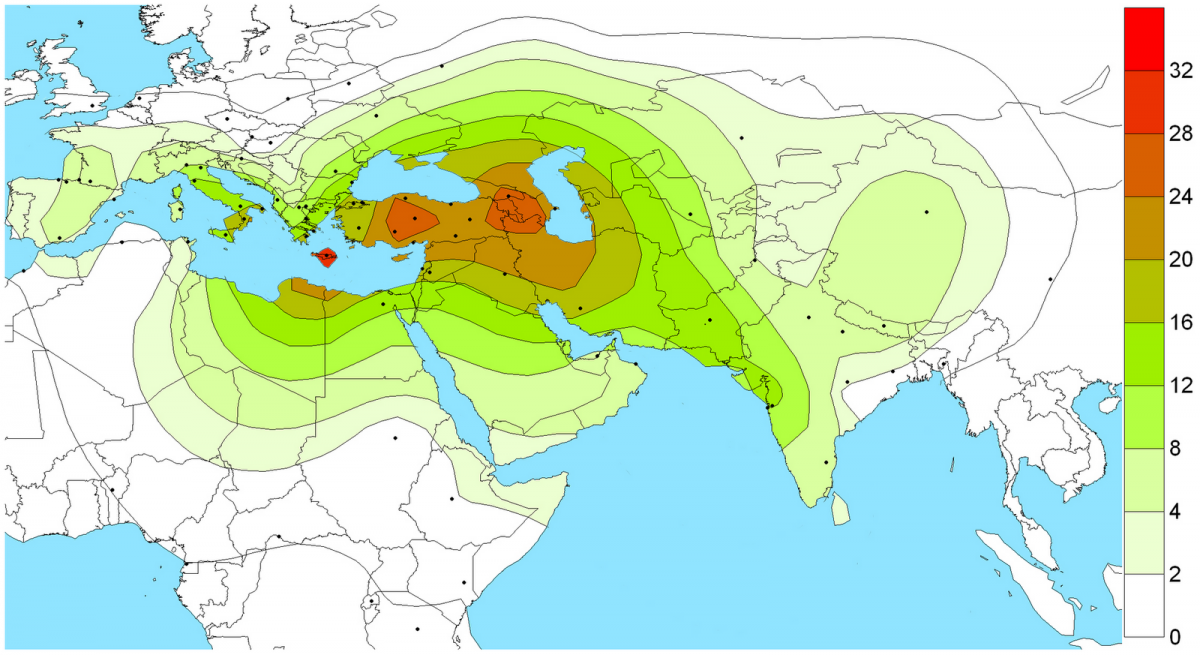The paper has a nice map of the frequency of haplogroup J2a-M410, which is an update of the previous map from Sengupta et al. (2006)
The most recent gene flow paternal gene flow from West Asia corresponds largely to this haplogroup.
Unfortunately the authors used the "evolutionary mutation rate" which I and others have criticized, hence their age estimates are inflated. J2a and R1a1 have similar Y-STR variances in the two studied populations (0.36 and 0.34), and their ages are roughly a third of those reported (with wide uncertainty), or about ~4ky.
This is roughly consistent with the postulated arrival of the Indo-Aryans in India, and should probably be added to the enumeration of cases where the genealogical mutation rate correlates well with prehistory. It also seems consistent with my speculation about a West Asian origin of the Indo-Aryans.
Haplogroup R1a1 is more diverse in India-Pakistan than in west Eurasia, but there is variation in diversity in different South Asian groups. It's possible that a subgroup of it also migrated from the west, but that possibility must remain speculative in the absence of even more Y-SNP structure within it. Interestingly:
The network analysis of R1a with other Indian populations failed to provide any regional or linguistic clustering (Fig. S2).
PLoS ONE 5(12): e15283. doi:10.1371/journal.pone.0015283
The Influence of Natural Barriers in Shaping the Genetic Structure of Maharashtra Populations
Kumarasamy Thangaraj et al.
Abstract
Background
The geographical position of Maharashtra state makes it rather essential to study the dispersal of modern humans in South Asia. Several hypotheses have been proposed to explain the cultural, linguistic and geographical affinity of the populations living in Maharashtra state with other South Asian populations. The genetic origin of populations living in this state is poorly understood and hitherto been described at low molecular resolution level.
Methodology/Principal Findings
To address this issue, we have analyzed the mitochondrial DNA (mtDNA) of 185 individuals and NRY (non-recombining region of Y chromosome) of 98 individuals belonging to two major tribal populations of Maharashtra, and compared their molecular variations with that of 54 South Asian contemporary populations of adjacent states. Inter and intra population comparisons reveal that the maternal gene pool of Maharashtra state populations is composed of mainly South Asian haplogroups with traces of east and west Eurasian haplogroups, while the paternal haplogroups comprise the South Asian as well as signature of near eastern specific haplogroup J2a.
Conclusions/Significance
Our analysis suggests that Indian populations, including Maharashtra state, are largely derived from Paleolithic ancient settlers; however, a more recent (~10 Ky older) detectable paternal gene flow from west Asia is well reflected in the present study. These findings reveal movement of populations to Maharashtra through the western coast rather than mainland where Western Ghats-Vindhya Mountains and Narmada-Tapti rivers might have acted as a natural barrier. Comparing the Maharastrian populations with other South Asian populations reveals that they have a closer affinity with the South Indian than with the Central Indian populations.
Abstract
Background
The geographical position of Maharashtra state makes it rather essential to study the dispersal of modern humans in South Asia. Several hypotheses have been proposed to explain the cultural, linguistic and geographical affinity of the populations living in Maharashtra state with other South Asian populations. The genetic origin of populations living in this state is poorly understood and hitherto been described at low molecular resolution level.
Methodology/Principal Findings
To address this issue, we have analyzed the mitochondrial DNA (mtDNA) of 185 individuals and NRY (non-recombining region of Y chromosome) of 98 individuals belonging to two major tribal populations of Maharashtra, and compared their molecular variations with that of 54 South Asian contemporary populations of adjacent states. Inter and intra population comparisons reveal that the maternal gene pool of Maharashtra state populations is composed of mainly South Asian haplogroups with traces of east and west Eurasian haplogroups, while the paternal haplogroups comprise the South Asian as well as signature of near eastern specific haplogroup J2a.
Conclusions/Significance
Our analysis suggests that Indian populations, including Maharashtra state, are largely derived from Paleolithic ancient settlers; however, a more recent (~10 Ky older) detectable paternal gene flow from west Asia is well reflected in the present study. These findings reveal movement of populations to Maharashtra through the western coast rather than mainland where Western Ghats-Vindhya Mountains and Narmada-Tapti rivers might have acted as a natural barrier. Comparing the Maharastrian populations with other South Asian populations reveals that they have a closer affinity with the South Indian than with the Central Indian populations.


